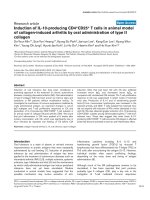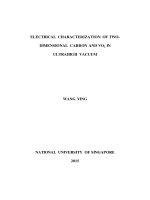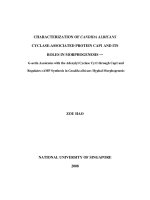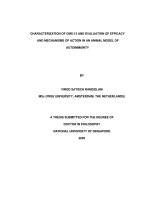Characterization of CMX 13 and evaluation of efficacy and mechanisms of action in animal model of autoimmunity
Bạn đang xem bản rút gọn của tài liệu. Xem và tải ngay bản đầy đủ của tài liệu tại đây (3.09 MB, 331 trang )
CHARACTERIZATION OF CMX-13 AND EVALUATION OF EFFICACY
AND MECHANISMS OF ACTION IN AN ANIMAL MODEL OF
AUTOIMMUNITY
BY
VINOD SATISCH RAMGOLAM
MSc (FREE UNIVERSITY, AMSTERDAM, THE NETHERLANDS)
A THESIS SUBMITTED FOR THE DEGREE OF
DOCTOR IN PHILOSOPHY
NATIONAL UNIVERSITY OF SINGAPORE
2005
II
THIS THESIS IS DEDICATED TO:
MY FATHER (IN MEMORIAL) FOR SECURING MY EDUCATION
MY MOTHER FOR BELIEVING IN MY FREEDOM
III
ACKNOWLEDGEMENTS
I wish to express my sincere gratitude and appreciation to my supervisors
Professor Yap Hui Kim and Associate Professor Ang Siau Gek, from the
Department Paediatrics and the Faculty of Chemistry, respectively, National
University of Singapore for their invaluable advice and encouragement. The
help of the collaborators in this project is highly appreciated. I am thankful to
Associate Professor Lai Yee Hing; Associate Professor Loh Chiong Shiong for
his kindness to let me work in botany lab; Associate Professor Koh Dow
Rhoon, for his helpful advices on the MRL-lpr/lpr SLE mouse model; Associate
Professor Fong Kok Yong for the SLE patient samples; Dr. Gilbert Chan for his
help on the histological slides.
I wish also to record my thanks to the following for their technical advice: Md.
Frances Lim, for her advice on HPLC; Mrs Ang, for her assistance in the
Botany lab; Md Ho for her assistance in the ELISSA’s; Melinda Leong (from
Biomed Diagnostics) for her professionel help on FASCan.
My work would not be complete without the helpful advises from my colleagues
in the Paediatrics lab: Danny Lai for helping me out with the histological
staining and preparing the slides and creatinine analysis; Wai Cheung for his
advice on quantitative real-time RT-PCR; Wee Song Yeo for doing his UROP
project under my supervision; Sylvia Ang for her work in the botany lab; Seah
IV
Ching Ching for helping out with administrative and lab work; Ai Wei Liang for
donating blood generously and Shirley Kham for being a great friend in need.
V
TABLE OF CONTENTS
TITLE PAGE I
DEDICATION II
ACKNOWLEDGEMENTS III
TABLE OF CONTENTS V
SUMMARY XII
LIST OF ABBREVIATIONS XVIII
LIST OF TABLES XXII
LIST OF FIGURES XXIV
LIST OF APPENDICES XXVIII
PUBLICATIONS AND CONFERENCE PAPERS XXIX
CHAPTER 1 INTRODUCTION 1
1.1 TRADITIONAL CHINESE MEDICINE AS IMMUNO-
SUPPRESSIVE AGENTS 2
1.2 BACKGROUND 7
1.3 EFFECT OF CM ON BIOLOGICAL PROCESSES in-vitro 11
1.4 PURIFICATION OF CMX-13 FROM CM 17
1.5 PRELIMINARY STUDIES OF CMX-13 ON A RAT
LUNG ALLOGRAFT MODEL OF ACUTE REJECTION 19
1.6 SLE: CLINICAL SYNDROME 22
1.7 PATHOGENESIS OF SLE 25
1.8 MRL-lpr/lpr AUTOIMMUNE MOUSE MODEL 29
VI
1.9 SCOPE OF THESIS 32
CHAPTER 2 MATERIALS AND METHODS 35
2.1 BIOASSAY GUIDED ISOLATION AND PURIFICATION OF
BIOACTIVE COMPOUNDS 35
2.1.1 Soxhlet Extraction 35
2.1.2 Solvent Partition 35
2.1.3 Isolation of CMX-13 from EtOAc extract by Flash
Column Chromatography and Reverse
Phase-Thin Layer Chromatography 36
2.1.4 Purification of CMX-13 fractions by Reverse
Phase High Performance Liquid Chromato
-graphy (RP-HPLC) 38
2.1.5 Nuclear Magnetic Resonance (NMR) 39
2.1.6 Liquid Chromatography- Mass Spectrometry 39
(LC-MS)
2.1.7 Bioassay Based On Inhibition of Cellular Proliferation 39
2.2 STUDIES ON CELL CYCLE PROGRESSION AND
APOPTOSIS 41
2.2.1 Patients and Controls
2.2.2 DEX dose response on PBMCs 45
2.2.3 Cell-Cycle Progression Analysis 46
2.2.4 Low Molecular DNA Isolation 48
2.2.5 Annexin V- Fluorescein-isothiocyanate (FITC) /PI 49
VII
Staining of Apoptotic Cells
2.3 CLINICAL AND HISTOLOGICAL STUDIES ON MRL-lpr/lpr
MICE 52
2.3.1 Breeding Conditions and Examination for
Clinical Disease 52
2.3.2 Treatment Groups 52
2.3.3 Urine Collection and Proteinuira Measurement 53
2.3.4 Sera collection from Mice 54
2.3.5 Serological Analysis 54
2.3.6 Preparation of Kidney Slides and Histological 56
Grading of Lupus Nephritis Examination
2.4 CYTOKINE GENE EXPRESSION STUDIES IN THE
MRL-lpr/lpr MICE 59
2.4.1 Isolation of Murine Splenic CD4
+
and CD8
+
T-Cells 59
2.4.2 Isolation of Glomeruli from Cortex of Mouse
Kidneys using the Graded Sieving Technique 62
2.4.3 RNA isolation and complementary DNA (cDNA)
preparation 64
2.4.4 Reverse Transcript PCR (RT-PCR) 64
2.5 PREPARATION OF STANDARDS FOR QUANTATIVE
REAL-TIME PCR 68
2.5.1 Cloning of Cytokine cDNA into Plasmids for 68
External Standard Curves Designated for
VIII
Quantitative Real-time- PCR
2.5.2 Calculation of Plasmid DNA Copy Number and 71
Dilution of Standards
2.5.3 Quantification of Cytokine mRNA transcripts by 71
Real-time PCR
2.5.4 Quantification of cDNA by real-time PCR 81
2.5.5 Statistical Analysis 81
CHAPTER 3 ISOLATION AND STRUCTURE ELUCIDATION
OF BIOACTIVE COMPOUNDS FROM RC 83
3.1 INTRODUCTION 83
3.2 RESULTS 89
3.2.1 Isolation and Immunosuppressive Bioassay of
Commercial Crude Herb 91
3.2.2 Immunosuppressive Effect of the Extracts
Obtained Through Solvent Partition 93
3.2.3 Immunosuppressive Effect of the Fractions
Obtained Through Flash Column
Chromatography 93
3.2.4 RP-HPLC and RP-TLC of CMX-13’ 97
3.2.5 Immunosuppressive Bioassay of RP-HPLC
Fractions Derived From CMX-13 99
3.2.6 Reverse Phase Thin Layer Chromatography
IX
(RP-TLC) 109
3.2.7 NMR Studies of CMX-13-5 110
3.2.8 LC-Mass Spectrometry on CMX-13-5 112
3.3 DISCUSSION 114
CHAPTER 4 EFFECT OF CMX-13 ON CELL-CYCLE EVENTS
AND APOPTOSIS 120
4.1 INTRODUCTION 120
4.2 RESULTS 129
4.2.1 Inhibition of Cell Proliferation of Jurkat cells by
CMX-13 129
4.2.2 Effect of CMX-13 on Cell-Cycle Progression in
Jurkat cells and PBMCs 131
4.2.3 Effect of CMX-13 on DNA Fragmentation in
Jurkat cells and PBMCs 137
4.2.4 Effect of CMX-13 on PS Exposure in Jurkat cells 140
4.2.5 Apoptosis induced by CMX-13 in PBMC of 143
SLE patients
4.3 DISCUSSION 154
CHAPTER 5 EFFECT OF CMX-13 ON THE MRL-lpr/lpr 158
SLE MOUSE MODEL
5.1 INTRODUCTION 158
X
5.2 RESULTS 163
5.2.1 Clinical Observation on the MRL-lpr/lpr Mice 163
5.2.2 Effect of CMX-13 on Proteinuria 169
5.2.3 Effect of CMX-13 on Anti-dsDNA Antibodies 172
5.2.4 Effect of CMX-13 on Serum Creatine levels 175
5.2.5 Histological Scoring of Lupus Nephritis in
MRL-lpr/lpr Mice 177
5.2.6 Effect of CMX-13 on Life Span of MRL-lpr/lpr Mice 184
5.3 DISCUSSION 190
CHAPTER 6 EFFECT OF CMX-13 ON CYTOKINE
GENE EXPRESSION IN THE MRL-lpr/lpr SLE
MOUSE MODEL 195
6.1 INTRODUCTION 195
6.2 RESULTS 202
6.2.1 IL-2 mRNA Expression in Splenic
CD4
+
and CD8
+
T- cells from MRL-lpr/lpr Mice 202
6.2.2 IFN-γ mRNA Expression in Splenic CD4
+
and CD8
+
T-cells, Liver and Glomeruli from
MRL-lpr/lpr Mice 207
6.2.3 IL-6 mRNA Expression in Splenic CD4
+
XI
and CD8
+
T-cells and Glomeruli from MRL-lpr/lpr 215
6.2.4 IL-10 mRNA Expression in Splenic CD4
+
and CD8
+
T-cells and Glomeruli from
MRL-lpr/lpr Mice 220
6.3 DISCUSSION 224
CHAPTER 7 CONCLUSION 230
7.1 CHARACTERIZATION OF CMX-13 231
7.2 MOLECULAR BASIS FOR IMMUNOSUPPRESSIVE
EFFECTS OF CMX-13 232
7.3 EFFECT OF CMX-13 ON MRL-lpr/lpr AUTOIMMUNE
MOUSE MODEL 235
REFERENCES 242
APPENDICES 292
XII
SUMMARY
Our research group’s interest in the “Ming Decoction of 21 Tonics for Kidney”
arose from treatment in a patient with lupus nephritis and chronic nephritic
syndrome, in whom clinical remission started after ingestion of this Chinese
herbal decoction (CM). Preliminary studies have demonstrated the
immunosuppressive potency of both the crude decoction CM, as well as the
active fraction CMX-13, a derivative of the herb Rubia cordifolia, on in-vitro T-
lymphocyte proliferation, as well as B-cell secretion of immunoglobulins in both
normal individuals as well as patients with SLE. In addition, we have shown
the efficacy of CMX-13 on preventing acute rejection in a rat lung transplant
model of hyperacute allograft rejection. This thesis utilizes the MRL-lpr/lpr
murine model of lupus nephritis to study the mechanism of the
immunosuppressive action of CMX-13 and its derivatives.
In the first part of this thesis, work was performed to characterize CMX-13,
which is the fraction which contains the active component(s) of the herb Rubia
cordifolia, following separation by liquid chromatography using spectroscopic
and chemical methods. RP-HPLC revealed that CMX-13 contained a mixture
of possibly 8 or more compounds. Two RP-HPLC fractions of CMX-13, namely
CMX-13-1 and CMX-13-5 had 100% immunosuppressive properties. The RP-
HPLC fraction CMX-13-5 contained fewer impurities than CMX-13-1 as
illustrated by their respective RP-HPLC profiles. Therefore we attempted to
elucidate the structure of CMX-13-5 by
1
H-NMR and LC-Mass spectrometry.
XIII
The LC chromatogram of CMX-13-5 showed a single peak, suggesting either a
single molecule with a weight of 807.5 or two molecules with a weight of 270
and 537.5.
1
H-NMR spectrum of CMX-13-5 was shown to resemble the
1
H-
NMR spectra of a bicyclic hexapeptide isolated by the group of Itokawa and co-
workers [Itokawa et al., 1992; Itokawa et al., 1993]. Subsequent to our work,
our collaborators were able to analyze the structure of the purified bioactive
compound in CMX-13’ (using material from the same source) and showed that
the bioactive compound in CMX-13’ was identical to a compound previously
identified by Itokawa and co-workers, namely, RA-VII.
In the second part of the thesis examined the effect of CMX-13 on both cell
cycle progression and the apoptotic events in peripheral blood mononuclear
cells (PBMC) isolated from normal controls and patients with SLE, as well as
Jurkat cells, a human T-cell line. In addition to its suppressive effect on PHA-
stimulated PBMC proliferation, CMX-13 was also shown to significantly inhibit
spontaneous Jurkat cell proliferation by >99% even at low concentrations of 1
µg/ml. The inhibitory effect of CMX-13 on Jurkat cell proliferation was not due
to inhibition of cell-cycle progression, but rather by the induction of
spontaneous apoptosis in cells in the G
0
/G
1
phase. This effect of CMX-13 on
apoptosis in Jurkat cells was confirmed by DNA fragmentation analysis and
Annexin-V staining. Apoptosis was induced at a very early phase, as was
demonstrated by the “sub-G1” or apoptotic peaks appearing in the cell-cycle
XIV
analysis. This mechanism of action was different from drugs such as
cyclohexmide, which induces apoptosis related to a G
0
/G
1
cell-cycle arrest.
In SLE, one of the hypothesis is that dysregulation of apoptosis might be
responsible for the induction of anti-nuclear antibodies, pathognomonic of the
disease. In some patients, decreased apoptosis in SLE appears to be
associated with increased production of a soluble form of the Fas molecule that
is capable of inhibiting apoptosis after a stimulus to proliferate [Cheng et al.,
1994], whereas other studies reported accelerated apoptosis of lymphocytes in
SLE patients [Emlen et al., 1992; Lorenz et al., 1998]. Similarly, in our SLE
patients, the percentage of apoptotic cells was increased with increasing
activity of the disease as measured by the SLICC score. Hence the
immunosuppressive mechanism of CMX-13 could be partly related to its effect
on apoptosis, especially in the context of suppression of SLE activity, where
increased apoptosis has been demonstrated.
In the third part of this thesis, we examined the effect of CMX-13 on the
development of lupus nephritis in the MRL-lpr/lpr mouse model of autoimmune
disease. MRL-lpr/lpr mice spontaneously develop an autoimmune disorder
with pathological features similar to human SLE, including vasculitis,
generalized lymphadenopathy, arthritis and a severe immune complex
glomerulonephritis, resulting in increased mortality, with the majority of mice
dying of renal failure at 16-24 weeks of age. In our experiments, these clinical
features, accompanied by elevation of serum anti-dsDNA antibody levels, were
XV
seen in the untreated MRL-lpr/lpr mice and the control group treated with the
solvent DMSO. The severity of the autoimmune disease increased with the
age of the mice, with the majority of the untreated and DMSO control mice
dying of renal failure at 16-24 weeks of age. Treatment of the MRL-lpr/lpr mice
with CMX-13 and dexamethasone (DEX) resulted in delay by at least 4 weeks
in the development of lymphadenopathy, which was also less severe than in
the control groups. All of the mice developed anti-dsDNA antibodies from the
age of 8 weeks, with the untreated and DMSO control mice having the highest
level of rise in antibody concentrations by 16 weeks of age, whereas both the
CMX-13 and DEX-treated groups had significantly lower anti-dsDNA antibody
levels. CMX-13 was also able to improve survival of the MRL-lpr/lpr mice
compared to the untreated or DMSO controls, where 48% of the mice treated
with CMX-13 were still alive at 22 weeks of age, whereas only 4.5% of the
untreated controls and 24% of the DMSO controls survived. Moreover, CMX-
13 treatment of MRL-lpr/lpr mice with progressive lupus nephritis resulted in
decrease in the degree of proteinuria and improvement in renal histological
indices. Hence CMX-13 appeared to be effective in attenuating the clinical
and histological disease activity in the MRL-lpr/lpr mouse model of SLE.
In the final part of the thesis, we examined the effect of CMX-13 on cytokine
gene expression in PBMCs (in particular CD4
+
and CD8
+
T-cells), liver and
glomeruli of the autoimmune MRL-lpr/lpr mouse. The mice were treated with
either DMSO (solvent control), CMX-13 or DEX, from the age of 12 weeks, and
real-time RT-PCR was used to examine IL-2, IL-6, IL-10 and IFN-γ mRNA
XVI
expression levels in PBMCs isolated at 16 weeks of age, and subsequently in
tissues and lymphocyte subsets from each of the groups of MRL-lpr/lpr mice
that were sacrificed at 23 weeks. Our studies showed that diseased MRL-
lpr/lpr mice which did not receive any treatment had decreased CD4
+
and CD8
+
IL-2/IFN-γ mRNA ratio at the age of 23 weeks, as well as upregulation of CD4
+
IL-10 mRNA expression, similar to other reports in the literature. In addition,
glomerular mRNA expression of IFN-γ, IL-6 and IL-10 were also increased. On
the other hand, the CMX-13 treated group showed significantly higher CD4
+
and CD8
+
IL-2/IFN-γ mRNA ratio, and this was associated with improved
clinical, serological and histopathological parameters, including survival.
However, CMX-13 treatment did not improve the abnormality in glomerular
IFN-γ, IL-6 and IL-10 gene expression.
In conclusion, one possible mechanism by which CMX-13 acts an
immunosuppressive agent in the treatment of lupus nephritis in the
autoimmune MRL-lpr/lpr mouse model is through the induction of apoptosis of
autoreactive lymphocytes. Auto-aggressive CD4
+
CD8
-
αβT-cells have been
postulated to be the driving force for autoreactive B-cells in SLE resulting in
abnormalities in cytokine production, and suppression of these autoreactive
lymphocytes could result in inhibition of autoantibody production, thus retarding
the progression of lupus nephritis.
XVII
Further investigations into the apoptotic mechanisms are required to examine
the transcription of apoptotic and cell-cycle genes, so that the exact molecular
targets of CMX-13 or its purified molecule, RA-VII can be identified.
XVIII
ABBREVIATIONS
Alb Albumin
AR Acute Rejection
Apaf1 Apoptotic protease activating factor
ARA American Rheumatological Association
AZT Azathioprine
BSA Bovine Albumin Serum
C serum Complement
CC Cellcept
cDNA Complementary DNA
CH Cycloheximide
CH
2
Cl
2
Dichloromethane
CFU-C Colony Forming Units
CM Chinese medicinal decoction
Con-A Concavalin A
cpm counts per minute
Cr Creatinine
CsA Cyclosporin A
DBP Diastolic Blood Pressure
DEPC Di-EthylPyroCarbonate
DEX Dexamethasone
DMEM Dulbecco’s modification of Minimal Essential Medium
DMSO DimethylSulfoxide
XIX
EX Ethyle acetate extract of CM
E.coli Escheria coli
EtOAc Ethyle Acetate
FasL Fas Ligand
FCS Fetal Calf Serum
FCS Forward Scatter
FITC Fluorescein IsoThioCyanate
HBBS Hanks Basal Salt Solution
HDCL Hydroxychloroquine
Hex n-Hexane
HLA-DR Human Leucocyte antigen-DR
ICAM-1 Intercellular Adhesion Molecule-1
IFN-γ Interferon gamma
IgG immunoglobulin G
IL Interleukin
LB Luria-Bertani
LC-MS Liquid Chromatography- Mass Spectrometry
lpr lymphoproliferate
LPS Lypopolysaccharide
MeOH Methanol
MHC Class II Major Histocompatilibility Complex Class II
MRL Mixed lymphocyte reaction
MRL-lpr/lpr MRL-mice mutated in the Fas gene
XX
MRL-wt MRL- wild type
mRNA messenger RNA
NMR Nuclear Magnetic Resonance
NZBxNZW New Zealand black x New Zealand white
PBMC Peripheral Blood Mononuclear Cells
PBS Phosphate Basal Solution
PCR Polymerase Chain Reaction
PHA Phytohemaglutinin
PI Propidium Iodide
PNL Prednisolone
PS Phosphadityl Serine
PWM PokeWeed Mitogen
RC Rubia cordifolia
RP-HPLC Reverse Phase- High Performance Liquid Chromatography
RP-TLC Reverse Phase-Thin Layer Chromatography
RT-PCR Reverse Transcript PCR
SCC Sideward Scatter
sFas soluble Fas
SLE Systemic Lupus Erythematosus
SLEDAI SLE-Disease Activity Index
SLICC Systemic Lupus International Collaborating Clinics
snRNP small nuclear ribonucleoprotein
TAC T-cell activation
XXI
TCM Traditional Chinese Medicines
TCR T-Cell Receptors
TNF Tumor Necrosis Factor
TWHf Tripterium wilfordii Hook F
TUP Total Urinary Protein Excretion
WHO World Health Organization
XXII
LIST OF TABLES
Chapter 1
Table 1.3.1 Effect of CM on T-cell colony formation
Table 1.3.2 Effect of CM on bone marrow cultures (colony forming
units or CFU-C)
Table 1.6.1 The 1982 revised ARA criteria for classification of SLE
Chapter 2
Table 2.1.3.1 Mobile phase for Flash Column Chromatography
Table 2.1.4.1 RP-HPLC conditions for CMX-13
Table 2.2.1.1 SLICC scoring system
Table 2.2.1.2 SLEDAI scoring system
Table 2.4.3.1 Reagents and Enzymes Used in the preparation of cDNA
Table 2.4.4.1 Mouse cytokine primers
Table 2.4.4.2 PCR Reagents
Table 2.4.4.3 PCR amplification conditions
Table 2.5.1.1 Cloning Reagents
Table 2.5.3.1 Primers for Real-Time RT-PCR
Table 2.5.3.2 Real-Time PCR reaction mixture using Roche LightCycler
DNA Master Kit 1
Chapter 3
Table 3.2.1.1 Immunosupression of PHA+PBMCs by EtOAc EXT
Table 3.2.2.1 Suppression of PHA+PBMCs by Solvent Extracts
Table 3.2.3.1 Bioassay-guided fractionation of CMX-13’
Table 3.2.4.1 RP- TLC of CMX-13, CMX-13-5 and CMX-13’
Table 3.2.5.1 Retention times of RP-HPLC isolates from CMX-13
Table 3.2.5.2 Immunosuppression of PBMC’s stimulated with PHA CMX
13 fractions isolated through RP-HPLC
Table 3.2.6.1 RP-TLC of CMX-13, CMX-13-5 and CMX-13’. Solvent
system: 90% EtOAc/ MeOH
Chapter 4
Table 4.2.1.1 Effect of serial dilutions of CMX-13 on Jurkat cell
proliferation (triplicate experiments)
Table 4.2.2.1 Jurkat cells incubated with DMSO, CMX-13 and CH in
different phase of the cell-cycle
Table 4.2.2.2 Effect of CMX-13 on PBMC’s stimulated with PHA
Table 4.2.5.1 Apoptosis induced by DEX in PBMCs derived from healthy
controls
Table 4.2.5.2 Percentage of apoptotic PBMCs in 20 SLE patients and
age/sex-matched healthy controls after treatment with
CMX-13
Table 4.2.5.3 Total SLICC/SLEDAI scores of SLE patients
Table 4.2.5.4 Details of Patients
XXIII
Chapter 5
Table 5.2.3.1 Serum anti-dsDNA antibody levels in MRL-lpr/lpr mice
at age 8, 12 and 16 weeks.
Table 5.2.4.1 Serum Creatine levels in the MRL-lpr/lpr mice
Table 5.2.5.2. Individual histological scores
Table 5.2.6.1 Cumulative survival of individual mice
Chapter 6
Table 6.1.1 Cytokine mRNA expression in MRL-lpr/lpr (d) and MRL-wt
(n) mouse organs by RNase protection assay
Table 6.2.1.1 IL-2 mRNA expression in CD4
+
T-cells from MRL-lpr/lpr
and MRL-wt mice at 23 weeks (mean ± SEM).
Table 6.2.1.2 IL-2 mRNA expression in CD8
+
T-cells from MRL-lpr/lpr
and MRL-wt mice at 23 weeks (mean ± SEM).
Table 6.2.2.1 IFN-γ mRNA expression and IL-2/IFN-γ mRNA ratio in
splenic CD4
+
T-cells from MRL-lpr/lpr and MRL-wt mice at
age 23 weeks (mean ± SEM).
Table 6.2.2.2 IFN-γ mRNA expression in splenic CD8
+
T-cells from MRL-
lpr/lpr and MRL-wt mice at 23 weeks (mean ± SEM).
Table 6.2.2.3 IFN-γ mRNA expression in glomeruli isolated from kidneys
of MRL-lpr/lpr and MRL-wt mice at 23 weeks
Table 6.2.2.4 IFN-γ mRNA expression in liver isolated from the MRL-
lpr/lpr and MRL-wt mice at 23 weeks (mean ± SEM).
Table 6.2.3.1 IL-6 mRNA expression in splenic CD4
+
T-cells from MRL-
lpr/lpr and MRL-wt mice at age 23 weeks
Table 6.2.3.2 IL-6 mRNA expression in splenic CD8
+
T-cells from MRL-
lpr/lpr and MRL-wt mice at age 23 weeks
Table 6.2.3.3 IL-6 mRNA expression in glomeruli isolated from kidneys
of MRL-lpr/lpr and MRL-wt mice at 23 weeks
Table 6.2.4.1 IL-10 mRNA expression in splenic CD4
+
T-cells from MRL-
lpr/lpr and MRL-wt mice at age 23 weeks (mean ± SEM).
Table 6.2.4.2 IL-10 mRNA expression in glomeruli isolated from kidneys
of MRL-lpr/lpr and MRL-wt mice at 23 weeks (mean ±
SEM).
Table 6.3.1 Effect of CMX-13 on cytokine mRNA expression in MRL-
lpr/lpr mice.
XXIV
LIST OF FIGURES
Chapter 1
Figure 1.2.1 Treatment of a SLE patients with CM
Figure 1.2.2 Effect of CM on serum complement (C) levels in a patient
with lupus nephritis
Figure 1.3.1 Effect of CM on PHA-stimulated lymphoproliferation as
measured by
3
[H]-Thymidine uptake
Figure 1.3.2 Effect of CM on T-cell activation markers CD25 (TAC) and
HLA-DR (DR)
Figure 1.3.3 Effect of CM on PWM-stimulated Peripheral Blood
Mononuclear Cells (PBMCs) immunoglobulin synthesis in
normal individuals.
Figure 1.3.4 Effect of CM and its EX on PBMC IgG production in SLE
Patients
Figure 1.3.5 Drug interactions of CM with CsA and dexamethasone
(DEX): Mean effect analysis
Figure 1.4.1 Comparison of the inhibitory effect of the various extracts
of CM on lymphoproliferation following PHA stimulation.
Figure 1.5.1 The effect of CMX-13 and CsA on acute rejection in the
Brown NorwayÆLewis rat lung transplant model.
Figure 1.5.2 Comparison of CMX-13 with CsA on rat splenic cell
proliferation following Con-A stimulation.
Figure 1.7.1 Hypothetical model for immunopathogenic events in the
development of SLE
Chapter 2
Figure 2.2.4.1 PS exposure on apoptotic cells
Figure 2.4.1.1 Flow-cytometric analysis of CD4
+
and CD8
+
T-cells
isolated from spleen.
Figure 2.4.2.1 Isolated glomeruli
Figure 2.5.1.1 EcoRI restriction digestion of inserts from plasmid.
Figure 2.5.3.1 Quantification of Mouse Cyclophilin-α mRNA transcripts by
quantitative real-time PCR.
Figure 2.5.3.2 Quantification of IL-2 mRNA transcripts by quantitative
real-time PCR.
Figure 2.5.3.3 Quantification of IFN-γ mRNA transcripts by quantitative
real-time PCR.
Figure 2.5.3.4 Quantification of IL-6 mRNA transcripts by quantitative
real-time PCR.
Figure 2.5.3.4 Quantification of IL-6 mRNA transcripts by quantitative
real-time PCR
XXV
Chapter 3
Figure 3.1.1 Strategy employed for the isolation of the bioactive
compound CMX-13 from RC
Figure 3.1.2 Strategy employed for the isolation of the bioactive
compound CMX-13’ from RC
Figure 3.2.1.1 Grounded roots of RC was extracted with EtOAc by
Soxhlet extraction.
Figure 3.2.2.1 Immunosuppressive effect of solvent extracts on
PHA+PBMCs.
Figure 3.2.3.1 Imunosuppressive properties of flash column
chromatography fractions.
Figure 3.2.3.2 Comparative bioassay of flash column chromatography
fractions CMX-13 and CMX-13’.
Figure 3.2.3.3 Immunosuppressive bioactivity in bioassay-guided
fractionation of CMX-13’.
Figure 3.2.4.1 RP-HPLC Chromatogram of CMX-13’
Figure 3.2.5.1 RP-HPLC Chromatogram of CMX-13.
Figure 3.2.5.2 Immunosuppression of PHA+PBMCs by subfractions of
CMX-13 after RP-HPLC.
Figure 3.2.5.3 RP-HPLC Chromatogram of CMX-13-1. Retention time
1.0-5.0 minutes.
Figure 3.2.5.4 HPLC Chromatogram of CMX-13-2. Retention time 25-27
Minutes
Figure 3.2.5.5 HPLC Chromatogram of CMX-13-3: retention time 27.0-
29.0 minutes.
Figure 3.2.5.6 HPLC Chromatogram of CMX-13-4. Retention time 29-
31 minutes.
Figure 3.2.5.7 HPLC Chromatogram of CMX-13-5. Retention time 31-
33 minutes.
Figure 3.2.5.8 HPLC Chromatogram of CMX-13-6. Retention time 33- 35
minutes.
Figure 3.2.5.10 HPLC Chromatogram of CMX-13-8. Retention time 36.0-
39.0 minutes.
Figure 3.2.7.1 NMR spectrum of CMX-13-5. (A) 500-MHz
1
H-NMR
Spectrum of CMX-13-5 in deuteriated MeOH.
Figure 3.2.8.1 LC-Mass Spectrum of CMX-13-5: (A) RP-HPLC \chromatogram;
(B) LC-Mass spectrum.
Figure 3.3.1 Structure of RA-VII as described by Itokawa and co-
workers
Chapter 4
Figure 4.1.1. Morphological changes during apoptosis and necrosis.
Figure 4.1.2. Blockade of the Fas apoptosis pathway by sFas results in
SLE
Figure 4.2.2.1 Representative DNA distribution histograms of Jurkat cells
incubated with DMSO, CMX-13 and CH for 24 hrs.









